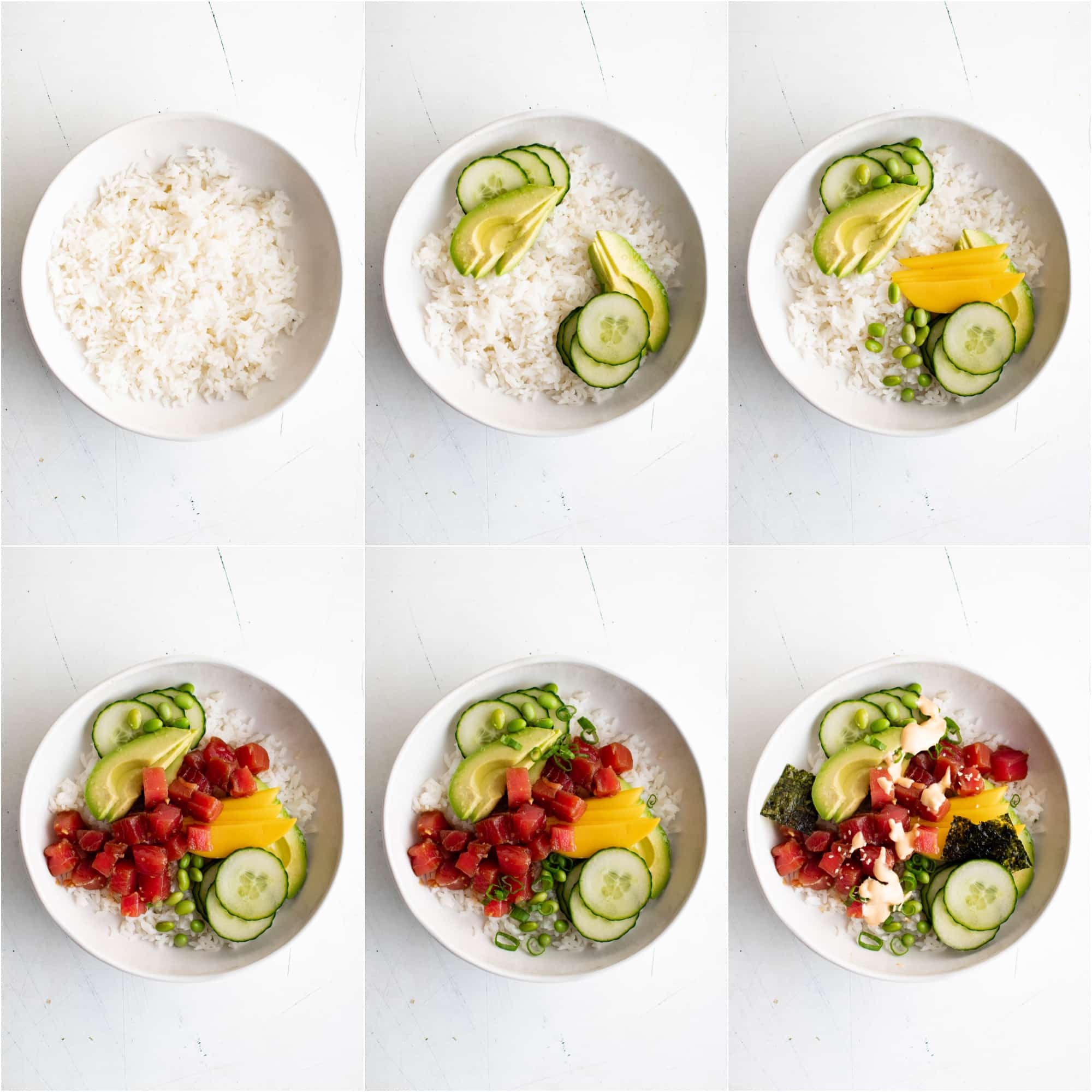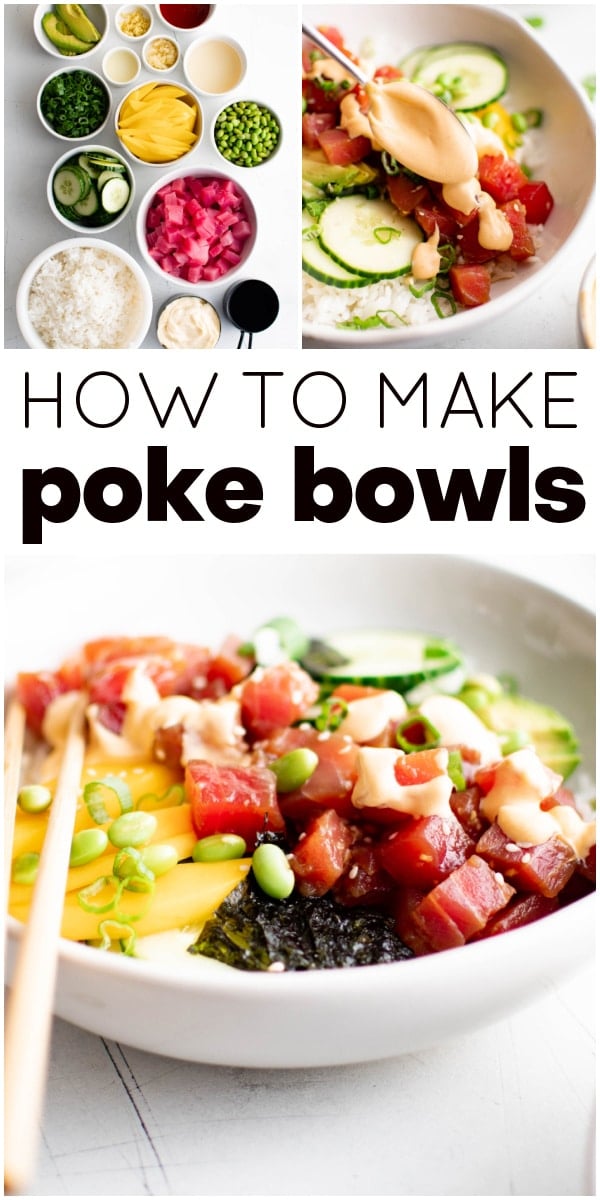This post may contain affiliate links. See my disclosure policy.
This homemade Poke Bowl Recipe is my take on the popular Hawaiian dish. Made with seasoned sushi-grade ahi tuna (or salmon), white rice, crisp veggies, sweet mango, and spicy Sriracha mayo, it’s fresh, flavorful, and completely customizable!

Who here has tried making their own poke bowls at home? Who even knew you could? For anyone curious, I’ve tied (more than a few times) and yes! You can absolutely make your own poke bowl at home. It’s actually pretty easy, not to mention way tastier (and WAY fresher) than anything you’ll order from a poke shop. In this post, I’m going show you how.
Table of Contents
Poke Bowl Ingredients
For the full list and amounts of each ingredient, jump to the recipe card found at the bottom of the post.
This poke bowl recipe includes a fresh and flavorful combination of cooked white rice, marinated “sushi-grade” ahi tuna, crunchy cucumbers, edamame, sliced mango, creamy avocado, green onions, nori (seaweed), and spicy mayo to tie it all together.
To elevate and customize your poke bowl even further, consider adding any of the following delicious toppings and mix-ins: seaweed salad, pickled ginger or pickled red onions, shredded carrots, furikake, tobiko or masago (fish eggs), spicy mayo or wasabi mayo. You can even swap regular white rice for coconut rice!
How Long Does Ahi Tuna Need to Marinate for Poke Bowls?
Ahi tuna should marinate for at least 15 to 30 minutes when preparing poke bowls. This is ideal for maintaining a firm, sashimi-like texture with balanced flavor. Up to 1 hour is okay, but avoid marinating for more than 2 hours to prevent the tuna from becoming mushy or overly salty.
How to Make Ahi Tuna Poke Bowls


Step 1: Combine the soy sauce, mirin, ginger, and garlic in a medium mixing bowl. Add the tuna and gently toss to coat. Cover and transfer to the refrigerator to marinate while you prepare the remaining ingredients.
Step 2: For the spicy mayonnaise, combine the mayo, Sriracha, and lime juice in a small bowl. Taste and add more Sriracha as needed. Cover and transfer to the refrigerator until you’re ready to prepare your poke bowls.

Step 3: To assemble, divide the rice between four bowls. Top the rice with marinated tuna, edamame, cucumber, avocado, mango, and green onions. Drizzle spicy mayo over the top of each bowl and serve immediately.
What is “Sushi-Grade” Fish?
“Sushi-grade” is an informal term used to describe fish that is considered to be of high enough quality to be eaten raw.
Tips for Buying “Sushi-Grade” Fish
When buying fish for poke bowls, always choose sushi- or sashimi-grade options from a reputable fishmonger or market that specializes in seafood for raw consumption. Tuna and salmon are the most popular choices, but you can also try hamachi, snapper, or even octopus. Look for loin or fillet cuts, which are tender and easier to work with.
To ensure freshness, the fish should have a clean, ocean-like smell (never fishy), firm texture, and bright, translucent color. Once purchased, keep it cold during transport—use a cooler with ice packs if needed—and store it in the coldest part of your fridge. For best quality and safety, consume within 24 hours.

Serving Ideas
Although one could argue that this is a meal in itself, I frequently serve it with small bites like edamame, miso soup, steamed gyoza (Japanese potstickers), Shishito peppers, or crispy coconut shrimp. I also like to serve a variety of tasty sauces like gyoza dipping sauce, Japanese Ginger Salad Dressing, and Thai sweet chili sauce.
Frequently Asked Questions
A poke bowl (pronounced poh-kay) is a traditional Hawaiian dish featuring diced raw fish, typically ahi tuna, marinated in a flavorful sauce like soy sauce or sesame oil. Served over a base of rice or leafy greens, poke bowls are topped with a variety of fresh ingredients such as avocado, edamame, cucumber, pickled vegetables, seaweed salad, sesame seeds, furikake, and sometimes spicy mayo or fish roe. The word “poke” means “to slice” or “cut” in Hawaiian, referring to the way the fish is prepared. Known for their balanced textures, fresh flavors, and endless customizability, poke bowls have become a popular and healthy meal option around the world.
Yes! This poke bowl recipe works just as well with sushi-grade salmon in place of ahi tuna. Make sure to choose high-quality, sashimi-grade salmon from a trusted source, and prepare it the same way—diced into bite-sized pieces and marinated for 15–30 minutes. The rich, buttery texture of salmon pairs perfectly with the rice, fresh toppings, and spicy mayo.
If you prefer a cooked version, try shrimp, cooked salmon, marinated tofu, chicken, or even canned tuna for a budget-friendly option.


Poke Bowl Recipe
Ingredients
Poke Ingredients
- ½ cup low-sodium soy sauce
- 2 tablespoon Mirin
- 1 tablespoon fresh ginger, grated
- 1 tablespoon garlic, minced
- 1 pound sushi-grade ahi tuna or salmon, cut into 1/2-inch cubes
Spicy Sriracha Mayonnaise
- 1 cup mayonnaise
- 3 tablespoon Sriracha, plus more to taste
- 1 teaspoon lime juice
For Assembly
- 6 cups cooked rice, sushi rice, white rice, or brown rice
- 1 cup shelled edamame
- 1 cup sliced English cucumber
- 1 avocado, peeled, pitted, and sliced
- 1 large mango, peeled, pitted, and sliced
- ¼ cup sliced green onions
Instructions
- Combine the soy sauce, mirin, ginger, and garlic in a medium mixing bowl. Add the tuna to the marinade and toss to coat. Cover and transfer to the refrigerator to marinate as you prepare the remaining ingredients. Note: For best results, marinate for at least 15 minutes or up to 24 hours.
- For the spicy mayonnaise, combine the mayo, Sriracha, and lime juice in a small bowl. Taste and add more Sriracha as needed, then set aside.
- To assemble, divide the rice into four bowls. Top the rice with marinated tuna, edamame, cucumber, avocado, mango, and green onions. Drizzle spicy mayo over the top of each bowl and serve immediately.
Notes
Nutrition
Nutrition information is automatically calculated, so should only be used as an approximation.















I had to substitute some items like sesame oil for fish oil, green onion for red. It was delicious! I also toasted the sesame seeds…
Thanks for the delicious feedback and rating, Roberta 😀